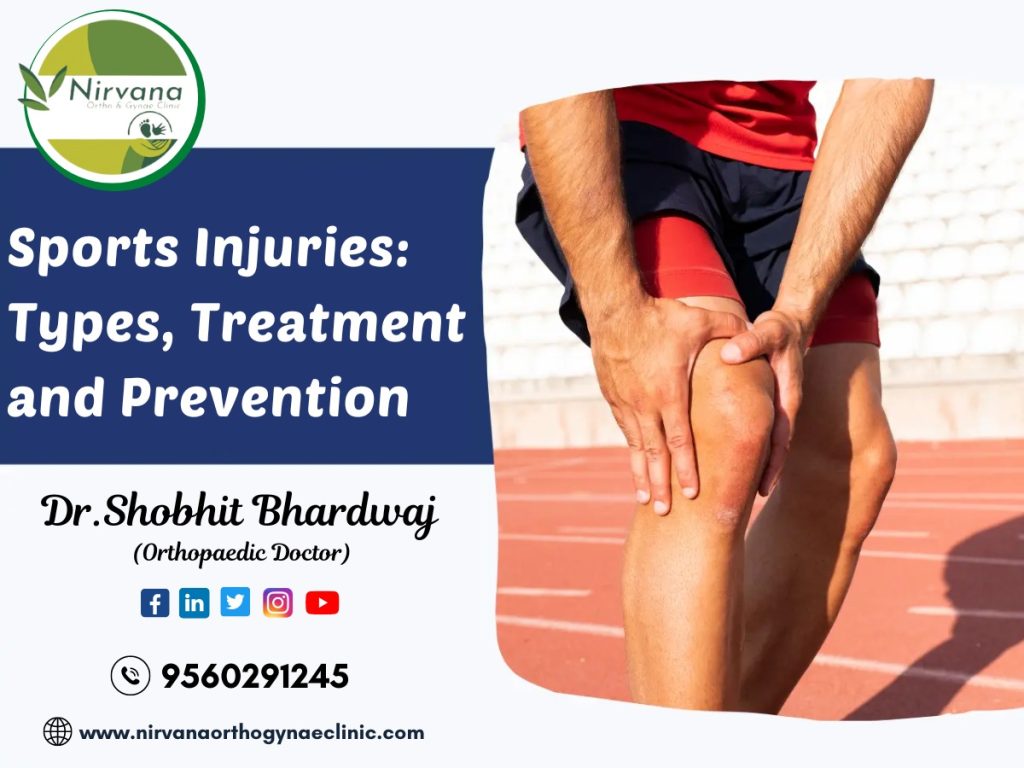Sports injuries encompass a wide range of conditions, and among them, sprains and strains top the list as the most common ones. Sprains occur when ligaments, which are the bands of tissue connecting bones, get stretched or torn. These injuries often result from sudden movements, impact, or excessive force applied to the affected area.
In This blog, we will discuss Sports Injuries Types, Treatment, and Prevention according to the specialist of Best Sports Injuries Treatment in Noida, Dr.Shobhit Bhardwaj.
Fractures and Broken Bones: Dealing with Structural Damage
Athletes may break bones or suffer fractures in more serious situations when participating in sports. When the bone’s continuity is broken, fissures or complete breaks result from fractures. Direct trauma, like a fall or collision, or repetitive stress on the bone can cause it. Timely medical care is essential for healing and appropriate alignment.
Dislocations: Joint Misalignment and Its Consequences
Dislocations occur when bones are moved from their natural placements at joints. An abrupt impact or a violent twisting of a joint outside of its usual range of motion frequently results in this kind of injury. Joint dislocations can be excruciatingly painful, and they need to be treated by a doctor right once to stop more damage and put the joint back in its proper place.
Concussions: Brain Injuries That Require Attention
Traumatic brain injuries, such as concussions, can happen during sports when head strikes are frequent. The brain moves quickly inside the skull as a result of fast acceleration or deceleration forces. Medical experts must properly assess and manage concussions since they can have dangerous side effects.
Muscle Cramps: The Unpleasant Surprise
Muscle cramps are abrupt, involuntary muscular contractions that can be extremely painful and uncomfortable. These frequently occur as a result of electrolyte imbalances, dehydration, or muscle weariness. Although cramps typically go away on their own, maintaining sufficient water and doing stretching exercises might help avoid them.
Tendonitis: Overuse Injury
Tendons, the fibrous fibres that connect muscles to bones, are injured by overuse in tendonitis, also known as tendinitis. An injured tendon may become inflamed and painful as a result of repetitive motions or severe strain. RICE therapy, which stands for rest, ice, compression, and elevation, is a popular kind of treatment.
ACL Tears: A Devastating Knee Injury
The anterior cruciate ligament (ACL) of the knee is one of the most feared sports injuries. ACL tears frequently occur during abrupt stops or direction changes. Athletes who desire to regain full knee function and resume their sport may find them to be painful and require surgical intervention.
Shin Splints: The Painful Reminder
Athletes who participate in sports involving running or jumping frequently have shin splints, which are characterized by pain along the shinbone (tibia). The condition is often brought on by repeated stress to the tissues close to the shinbone. Recovery requires rest, ice, and a slow return to activities.
Treatment Options for Sports Injuries
Early intervention and proper management are crucial for the treatment of sports injuries. Treatment options might range from rest to physical therapy to medication to surgery, depending on the kind and extent of the injury.
Prevention Techniques: Safeguarding Against Injuries
Sports injuries cannot be completely prevented, but several preventative steps can greatly lower the risk that they will occur. Injury prevention requires following the right warm-up and stretching routines, working on your strength and conditioning, wearing the right protective gear, and paying attention to your body’s signals.
Proper Warm-up and Stretching: Preparing Your Body
It is essential to stretch and warm up the body before participating in any physical activity. A warm-up improves blood flow, preheats muscles, and gets them ready for the demands to come. Include dynamic exercises and stretches that concentrate on the particular muscles employed in your sport.
Strength and Conditioning: Building Resilience
Frequent strength and conditioning workouts are crucial for preventing injuries. Increasing muscle and connective tissue strength lowers the risk of injury by improving the way forces are distributed and absorbed during physical activity. Concentrate on workouts that target the precise muscle groups necessary for your sport and gradually boost the effort and intensity over time.
Wearing Protective Gear: Essential Equipment
To prevent sports injuries, the proper protective gear must be used. Helmets, knee, elbow, and mouthguard pads, as well as the right footwear, can offer vital protection for the body’s most susceptible parts. Be sure your equipment is safe, fits properly, and is in good shape.
Rest and Recovery
Proper rest and recuperation are crucial parts of injury prevention that are frequently disregarded. Pushing through discomfort or exhaustion might result in overuse injuries and long-term effects. To improve healing and avoid muscular imbalances, incorporate active recovery techniques like foam rolling, moderate stretching, and low-impact exercises.
Conclusion
Athletes who wish to stay fit and active must comprehend the different forms of sports injuries, as well as how to treat and prevent them. Athletes can reduce their chance of injury and improve their performance on the field by becoming familiar with common injuries, using the right treatments, and taking preventive measures. Take care of your body because it is your most significant possession if you want to continue doing sports for a long time. If you are seeking the Best Sports Injuries and Arthroscopy in Noida, Contact us now.

